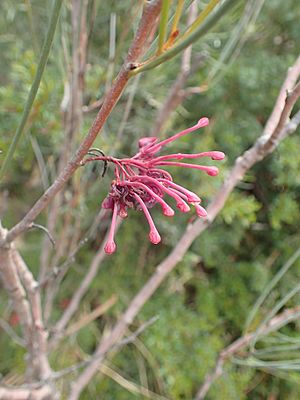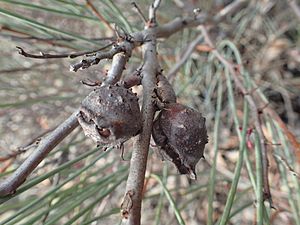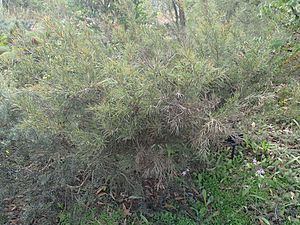Hakea strumosa facts for kids
Quick facts for kids Hakea strumosa |
|
|---|---|
 |
|
| Hakea strumosa flowers in Kings Park, Perth | |
| Scientific classification | |
| Genus: |
Hakea
|
| Species: |
strumosa
|
 |
|
| Occurrence data from Australasian Virtual Herbarium | |
Hakea strumosa is a special kind of shrub found only in certain parts of Western Australia. It belongs to the Proteaceae plant family. This plant is quite dense and prickly, and in spring, it bursts with many small, beautiful deep pink or red flowers.
What Does Hakea strumosa Look Like?
Hakea strumosa is a round, thick shrub that usually grows to be about 0.6 to 1.5 meters (2 to 5 feet) tall. It can spread out to be 1 to 2 meters (3 to 7 feet) wide. Unlike some plants, it doesn't have a special woody base called a lignotuber that helps it regrow after a fire.
- Branches and Leaves: The young branches and new leaves are smooth. Sometimes, they have fine, rusty-colored hairs. The leaves are stiff and shaped like needles. They are about 2.5 to 11 centimeters (1 to 4 inches) long and very thin, only about 1.3 to 1.8 millimeters wide. Each leaf ends in a sharp point that can be 1 to 4.8 millimeters long.
- Flowers: This plant produces many small, deep pink or red flowers. They grow in groups along the upright branches, usually with 4 to 10 flowers in each cluster. The flowers have a mild scent. Each tiny flower has overlapping leaf-like parts called bracts, which are covered in rough hairs. The flowers also have a smooth stalk (called a pedicel) and a long part called a pistil. The colorful part of the flower, called the perianth, is red and yellow. It's smooth and covered in a bluish-green powdery layer. Hakea strumosa usually flowers from September to October.
- Fruit: After flowering, the plant grows large, smooth, pear-shaped fruits. These fruits are about 3 to 6 centimeters (1 to 2 inches) long and 2 to 3.5 centimeters (0.8 to 1.4 inches) wide. They have two small horn-like bumps at the end, each about 2 millimeters long.
Where Does Hakea strumosa Grow?
This plant is found in the Wheatbelt, Great Southern, and Goldfields-Esperance regions of Western Australia. It likes to grow in low, open areas with sandy soil, sometimes over a type of rock called laterite. You can find it from Tammin in the central wheatbelt, all the way south to Bremer Bay and Esperance.
Is Hakea strumosa Endangered?
The Western Australian Government's Department of Parks and Wildlife has looked at Hakea strumosa. They have officially said that it is "not threatened," which means it is not currently in danger of disappearing.



